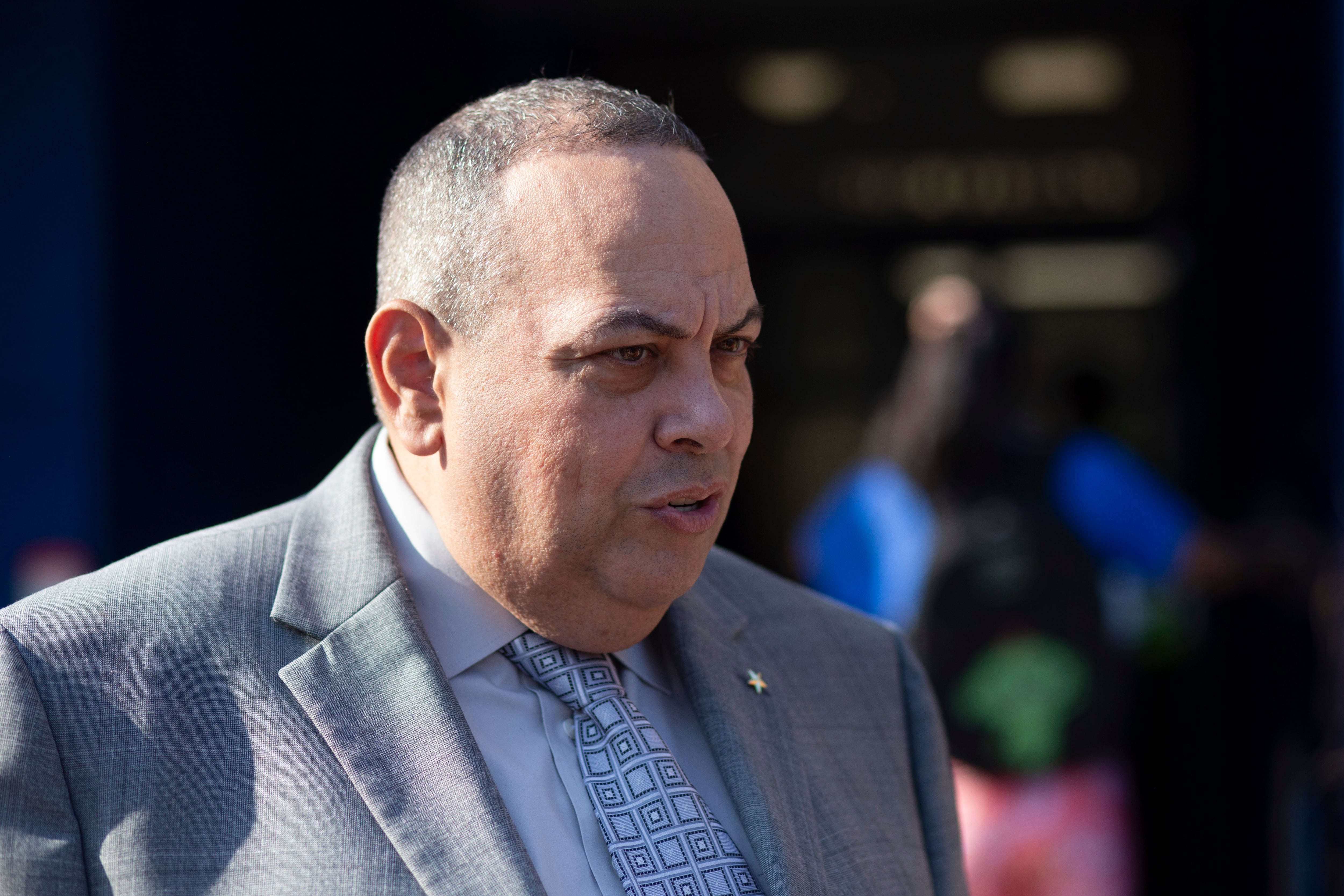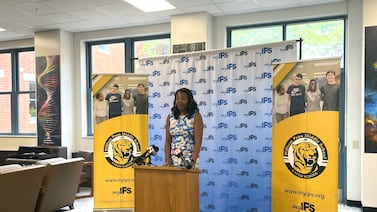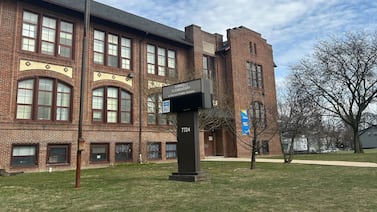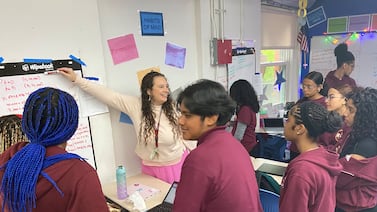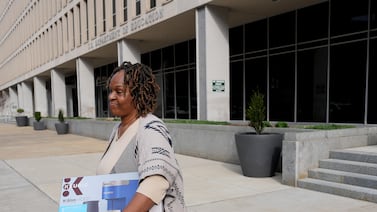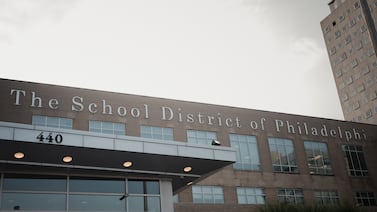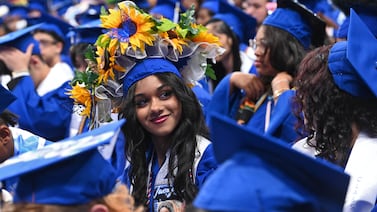Sign up for Chalkbeat Newark’s free newsletter to keep up with the city’s public school system.
When Newark Public Schools opens its doors to roughly 40,000 students next month, the district will expand the use of an AI program in schools and implement solutions to ongoing facilities needs, Superintendent Roger León said in a wide-ranging interview this week.
In a conversation with WBGO 88.3 FM host Michael Hill and Chalkbeat Newark this week, León provided insight into the district’s 10-year strategy, known as “The Next Decade: 2020-30,” which aims to tackle learning loss, implement new curriculum, scale up tutoring efforts, address emerging issues such as building needs, and add more student services, among other goals.
In the 2024-25 school year – year five of the plan – school leaders will use artificial intelligence to inform teaching and learning, use remaining COVID relief dollars to support academic recovery efforts, and expand tutoring efforts. León also addressed the district’s plans to improve its aging school buildings and the possibility of asking Newark voters to approve a construction bond referendum to support those projects.
“We’re looking at strategies during year five that are essential towards really transforming the school district in the fashion that we strongly believe is consistent with some of the aspects of what distinguished the school district several decades ago,” said León during the interview, which was recorded Tuesday and scheduled to stream on WBGO’s website at 8 p.m. Thursday and then again on 88.3 FM on Sunday, Aug. 25, at 11 p.m.
This year, the district is managing a $1.5 billion budget and must confront a number of pressing needs such as improving school buildings, raising attendance rates, supporting the district’s most vulnerable students, and grappling with the impacts of racial harassment and diversity issues. It is also furthering AI technology to support teachers in the classroom and keep students safe, León said.
Here are takeaways from the interview:
Newark builds on new curriculum, AI programs
This school year, Khanmigo, an AI chatbot designed to act as a tutor for students and an assistant for teachers, will launch in 14 schools in Newark’s North Ward and expand to grades 3-8, according to Paul Brubaker, the district’s communications director. The AI program, developed by online learning giant Khan Academy, was piloted at First Avenue Elementary school in the North Ward in grades 5-8 last year. The program is designed for classrooms and accessed through Khan Academy’s website.
The district will use Khanmigo to help teachers “make intentional academic decisions” and “influence the academic program,” León said. Khan Academy is also helping the district analyze state testing data to determine the impact of Khanmigo on student growth and achievement.
Through Khanmigo, students take assessments, with teachers using the results to identify students with similar academic needs and provide targeted instruction, León explained. The district is also using Khanmigo to support tutoring efforts by allowing students to pose questions about lessons they learned in the classrooms, León said, and in turn, informing professional development sessions for teachers, who “are at the heart” of AI work.
The program is also being used to expose students to coursework in different grades, said León, pointing to a third grader who completed math work at a sixth, seventh, and eighth grade level.
At the end of last school year, the district also announced new free training on Khanmigo’s features for teachers that will help educators create lessons, recommend assignments, and provide refreshers on different topics.
“It’s difficult to teach any child but ultimately, if there are groups of children that are having the same difficulties, making them a team and addressing their needs and having them help each other becomes one strategy,” Leòn added on Tuesday.
This year, León said the district is “being very aggressive and intentional” in introducing new math and literacy initiatives.
Last fall, the district developed a strategy to tackle students’ difficulties in writing and English language arts and plans to introduce new approaches to teaching phonics, implement explicit writing strategies, and support teachers’ knowledge of an evidence-based reading approach known as the science of reading this upcoming school year.
COVID relief dollars used on long-term items, programs
In addition to using Khanmigo to support tutoring efforts, León also said COVID relief dollars helped scale up the tutoring program districtwide.
In 2018, the district received more than $287 million from three federal relief packages to help schools respond to the pandemic, reopen classrooms, and support students’ emotional and academic recovery. The district focused those funds on three areas: facilities, technology, and teaching and learning, León said on Tuesday.
In the classroom, those funds allowed the district to expand its summer program, Saturday school, and tutoring efforts, which it plans to continue this school year, León said. COVID relief dollars helped “offset” the cost of tutoring, León added, but now, the district must fully pay for tutoring as those funds are set to expire by October.
“We’ll concentrate those dollars on areas of English Language Arts and math so that every child starting on the first day of school could actually receive tutoring services in those two content areas,” León added.
León also said the district was “strategic” in utilizing COVID dollars to pay for services or items that would provide long-term benefits. The district purchased new books and Chromebooks for students, items that will “last beyond the October 2024 deadline,” León added. The funds were not used to pay for additional teachers, León said, since the district could then incur the costs of paying for their salaries.
COVID dollars were also used to partly fund a $12 million project to install more than 7,700 AI cameras districtwide, a plan approved by board members in May.
“So our strategy was to try to use these dollars because we know we’re never going to see them again,” León said.
District might ask Newark voters to approve construction funding
Addressing the needs of Newark’s old school buildings is another challenge, said León, who raised the prospect of a bond referendum to pay for needed improvements.
COVID dollars helped fund improvements to the district’s aging school buildings, such as the installation of contactless water fountains – a $5 million project that began in 2022 with a plan to place over 800 fountains in schools – León said Tuesday. Less than 200 contactless fountains remain to be installed, León added.
But according to a needs assessment completed this year, just over $2.5 billion is needed to fix all Newark schools. In New Jersey, the state’s Schools Development Authority must pay for construction projects in Newark and 30 other high-poverty districts.
This year, the state promised to replace 13 school buildings built before 1920, but the district has identified 33 buildings that need replacing, León said. The SDA has said it cannot begin its projects without funding from the legislature, which provides the Authority with funds on a “pay as you go” basis.
“So, if the state of New Jersey does not act, and if we do not utilize the court system to help us in that action, what are we left to do?” León said Tuesday. “The only thing that we’re left to do is ask the citizens of Newark if, in fact, they would vote in favor of a referendum.”
Under New Jersey law, a ballot question is required for any school district to issue new bonds for construction projects to improve existing facilities or to build new facilities. Once voters sign off, a bond referendum authorizes bonds to be sold to raise funds for school projects and the bond debt is paid off using taxpayer funds over several years. To issue a construction bond, the district can raise local taxes, but Newark voters would need to approve any changes resulting in a more than 2% increase in property taxes, according to a new state law.
León said Newark voters may not see a bond referendum question in April’s school board election, but district officials are in the process of “assessing” that possibility and the amount they would ask voters to approve. He also said the district would have to ensure state and local officials are aware of Newark’s facilities needs “because they could assist us in advocating with the governor and state legislature” for more funding to cover construction projects.
Regardless of the bond, León wants community input to prioritize school construction projects in Newark. He plans to host a series of community meetings this school year to determine what 13 schools should be replaced through the state’s promise and allow residents to weigh in on a bond referendum, “if in fact, securing a bond is what we would need to do,” León said.
“Ultimately it will be the residents who either give it a thumbs up or thumbs down,” León said. “And so we’ll spend months, if that’s what we eventually do, to allow the community to weigh in, to be strategic in what we do every time.”
Jessie Gómez is a reporter for Chalkbeat Newark, covering public education in the city. Contact Jessie at jgomez@chalkbeat.org.

